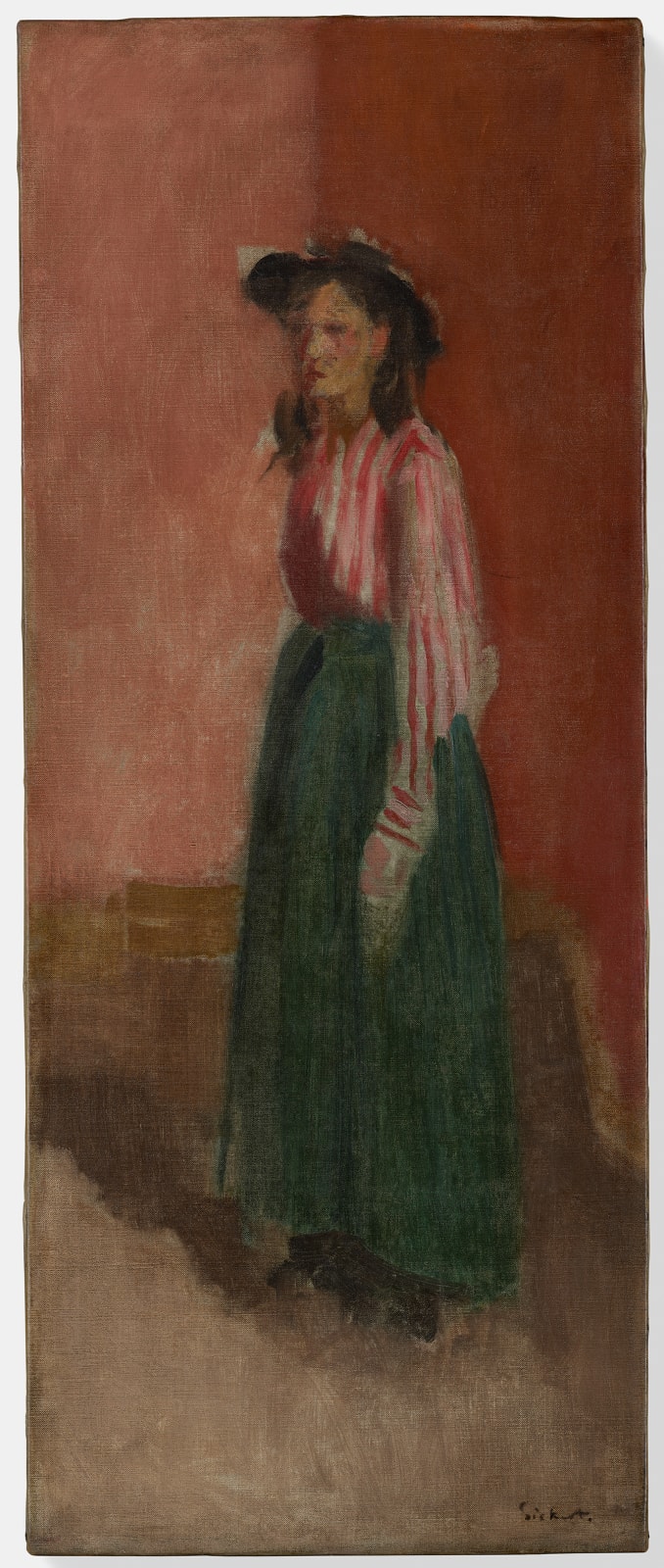Walter Richard Sickert 1860-1942
Le Corsage Raye: Standing Woman, c1893-4
oil on canvas
30 x 12 1/4 inches
76.2 x 31 cm
76.2 x 31 cm
signed
This early figure study reminds us that Sickert’s principal training as an artist was his apprenticeship in Whistler’s studio. There is no external or documentary clue as to the date...
This early figure study reminds us that Sickert’s principal training as an artist was his apprenticeship in Whistler’s studio. There is no external or documentary clue as to the date of Le Corsage Rayé, but on stylistic grounds it is close to Sickert’s Whistlerian self-portrait, L’Homme à la Palette (Art Gallery of New South Wales) which was exhibited at the New English Art Club in spring 1894, and to Portrait of Aubrey Beardsley (Tate, London) reproduced in The Yellow Book in July 1894. The three paintings are identical in size and format. Each represents a slim full-length figure set within a narrow space; Beardsley hints at a churchyard setting, but the whereabouts of the other two are anonymous. In all three the definition is abbreviated (the similarity of the hands as flat rectangular slabs of paint is especially striking), and wholly dependent upon the subtle relation and truth of the closely graded tones. In all three the palette is restricted and muted, the paint thin and smooth in texture. The chief difference is that the figure in Le Corsage Rayé is an unidentified model, albeit with her own charm and grace, rather than an identified sitter. In all these respects we are reminded of Whistler, even of Sickert’s later criticism of his master that ‘If a figure has no feet to speak of, we are asked to accept the fact as “atmosphere”’. Although by 1893-4 Degas had largely supplanted Whistler as his mentor, Sickert’s emancipation was sufficiently assured to allow him to include – when it suited him - Whistlerian prototypes in his repertoire of styles. It particularly suited him during the 1890s, the decade when he tried to establish a portrait practice.
The title Le Corsage Rayé is original and straightforward: the striped blouse. It was almost certainly painted in England and presumably taken to France when Sickert moved to Dieppe in autumn 1898. His many studios were chaotic and it is probable that he lost sight of the painting only to rediscover it in Dieppe between 1907 (when he had an exhibition with Bernheim Jeune in which this painting was not included) and 1909, when it already belonged to Bernheim and was included in their two-day exhibition in Paris and subsequent sale at the Hôtel Drouot on 21 June. Unsold at Drouot, it was bought subsequently from Bernheim Jeune by John Caftanzoglou. Caftanzoglou lived in Athens but came to Paris frequently and was certainly there in June 1909 when he bought Sickert’s Regrets at the sale. Both paintings remained in his family for over 100 years.
©Wendy Baron
The title Le Corsage Rayé is original and straightforward: the striped blouse. It was almost certainly painted in England and presumably taken to France when Sickert moved to Dieppe in autumn 1898. His many studios were chaotic and it is probable that he lost sight of the painting only to rediscover it in Dieppe between 1907 (when he had an exhibition with Bernheim Jeune in which this painting was not included) and 1909, when it already belonged to Bernheim and was included in their two-day exhibition in Paris and subsequent sale at the Hôtel Drouot on 21 June. Unsold at Drouot, it was bought subsequently from Bernheim Jeune by John Caftanzoglou. Caftanzoglou lived in Athens but came to Paris frequently and was certainly there in June 1909 when he bought Sickert’s Regrets at the sale. Both paintings remained in his family for over 100 years.
©Wendy Baron
Provenance
Collection Bernheim Jeune, ParisCollection John Caftanzoglou
Collection Mary Averoff
Exhibitions
Paris, Bernheim Jeune, 18-19 June, 1909Paris, Hôtel Drouot, 20 June, sale on 21 June, 1909
Literature
Adolphe Tavernier, Vente de 84 œuvres de Walter Sickert, Paris, Bernheim Jeune 1909Wendy Baron, Sickert: Paintings and Drawings, published for The Paul Mellon Center for Studies in British Art by Yale University Press New Haven and London, 2006. Reproduced and mentioned p193 & 194
1
of
5
Join our mailing list
* denotes required fields
We will process the personal data you have supplied to communicate with you in accordance with our Privacy Policy. You can unsubscribe or change your preferences at any time by clicking the link in our emails.



